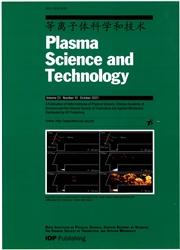E//B中性颗粒分析仪的研究进展
IF 1.8
3区 物理与天体物理
Q3 PHYSICS, FLUIDS & PLASMAS
引用次数: 0
摘要
四川大学和西南物理研究所设计并研制了E//B中性粒子分析仪(NPA)。E//B NPA的主要目的是测量HL-2A/M托卡马克上快离子的分布函数。E//B NPA包含三个主要单元,即剥离单元、分析单元和检测单元。汽提装置采用气提室。给出了汽提室的模拟和波束试验结果,并为分析单元设计和构造了由一块钕铁硼永磁体和两块平行电板提供的平行电场和磁场。磁场和电场的校准在50 kV电子回旋共振离子源(ECRIS)平台上进行。检测单元由32个LYSO探测器模块组成,按2排排列。用241Am、137Cs和152Eu源和50kv ECRIS平台测量了探测器模块的α、氢离子(H+、H+2和H+3)和γ的响应函数。总体结果表明,所设计的E//B NPA装置能够测量能量高于20 keV的中性氢原子和氘核原子的强度。本文章由计算机程序翻译,如有差异,请以英文原文为准。
The research progress of an E//B neutral particle analyzer
Abstract An E//B neutral particle analyzer (NPA) has been designed and is under development at Sichuan
University and Southwestern Institute of Physics. The main purpose of the E//B NPA is to measure the
distribution function of fast ions on HL-2A/M tokamak. The E//B NPA contains three main units, i.e.
the stripping unit, the analyzing unit and the detection unit. A gas stripping chamber was adopted as
the stripping unit. Results of the simulations and beam tests for the stripping chamber are presented.
The parallel electric and magnetic fields provided by a NdFeB permanent magnet and two parallel
electric plates were designed and constructed for the analyzing unit. The calibration of the magnetic
and electric fields was performed at the 50 kV electron cyclotron resonance ion source (ECRIS)
platform. The detection unit consists of 32 LYSO detector modules arranged in 2 rows. The response
functions of α, hydrogen ions (H+, H+2 and H+3 ) and γ for a detector module were measured with
241Am, 137Cs and 152Eu sources together with the 50 kV ECRIS platform. Overall results indicate that
the designed E//B NPA device is capable to measure the intensity of neutral hydrogen and deuteron atoms with energy higher than 20 keV.
求助全文
通过发布文献求助,成功后即可免费获取论文全文。
去求助
来源期刊

Plasma Science & Technology
物理-物理:流体与等离子体
CiteScore
3.10
自引率
11.80%
发文量
3773
审稿时长
3.8 months
期刊介绍:
PST assists in advancing plasma science and technology by reporting important, novel, helpful and thought-provoking progress in this strongly multidisciplinary and interdisciplinary field, in a timely manner.
A Publication of the Institute of Plasma Physics, Chinese Academy of Sciences and the Chinese Society of Theoretical and Applied Mechanics.
 求助内容:
求助内容: 应助结果提醒方式:
应助结果提醒方式:


